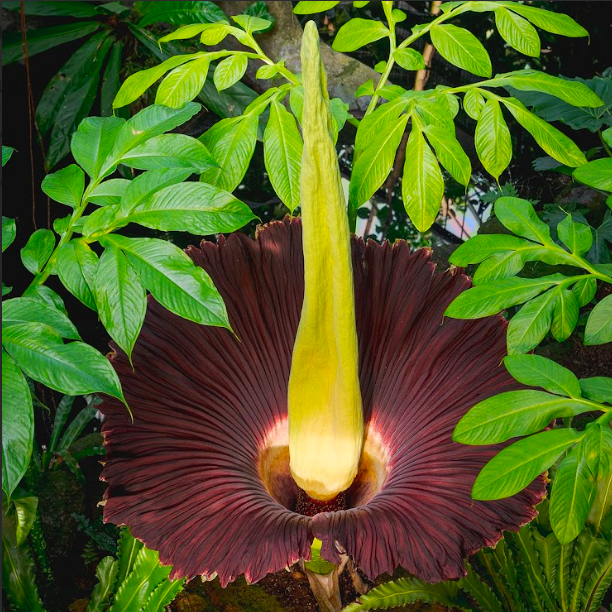NYBG Holds Its Breath As The “Corpse Flower” Blooms
Spring has sprung for the 2023 season at the New York Botanical Gardens (NYBG) just across the street from Fordham University. While it is common knowledge that any Fordham student can gain free access to the Botanical Garden, the newest edition in the greenhouse has not gained much traction. The Enid A. Haupt Conservatory is home to the NYBG’s only Amorphophallus Titanum which is currently preparing to bloom.
The Amorphophallus Titanum also goes by the names Titan-arum or, the more gruesome of the three names, the “corpse flower.” This plant is traditionally native to Sumatra, an island in Indonesia. It contains a flesh-like spike in the center of the plant, the spadix, housed in a large red leaf with smaller flowers curling around the spadix sprouting out of the leaves. The plant also produces fruit once it reaches the necessary level of maturity. This increases chances of the plant reproducing when birds eat the fruit and scatter the remains in soil. The corpse flower’s gargantuan structure is the largest bloom in the entirety of the plantae kingdom.
Another interesting fact about this flower relates to the title of “corpse flower.” The common name is inspired by the smell, or rather stench, that emerges when the flower blooms. It is said to have a similar odor as rotting flesh. However, the plant emits this smell in an effort to attract pollinators that tend to have a more carnivorous diet. The petals also mimic that of a dead animal and take on a meaty red hue.
The titan-arum first debuted in the Botanical Gardens nearly a century ago in 1932. It was the first one to take residence in the Western Hemisphere and caused much excitement when the first bud appeared on the flower in 1937. It finally bloomed its first flower on June 8, 1937, causing the Enid A. Haupt Conservatory to be overrun with plant-lovers, reporters and excited citizens all hoping to see the special plant. The spadix that bloomed in 1937 is the longest to this day, measuring out to be around eight feet.
After the flowering of a second plant in 1939, the corpse flower received a special title. The President of the Bronx Borough decided to name the Amorphophallus Titanum the official flower of the Bronx. Sadly, this title was revoked in 2006 when they decided to name the daylily the borough’s official flower.
The excitement surrounding this particular plant might seem strange seeing how the flower itself smells of rotting flesh. A reason why the NYBG is so excited at the impending blooming of the flower is its rarity. This plant follows a highly unpredictable flowering pattern that makes the few times it buds so special. On average, the Titan-arum takes about seven or more years to muster enough energy to properly bloom.
Also, mimicking the weather conditions of the Sumatra can be a difficult task. If the humidity or temperature is too high or low, it is not sufficient conditions for the corpse flower to plant. The flower contains an underground storage organ called the “corm.” The plant will not begin the process of blooming until the corm weighs at least 35 pounds. However, it can build up to weigh over 110 pounds, making it difficult to transport and house. So many moving factors contributing to a successful plant makes the blooming all the more exciting.
The Titan-arum is also currently an endangered plant. The U.S. Botanical Garden estimates that there is only about 1,000 Amorphophallus Titanum left in the wild currently. There are a handful of corpse flowers growing in conservatories across America, but it is not a common plant to find. Only professional botanists are attempting to cultivate this plant due to the Titan-arum naturally disappearing from its home. This is due to the natural environment it grows in being destroyed for oil plantations or logging. The fact this plant can grow so far away from its home is no small feat. Therefore, the NYBG recognizes the importance of preserving the plant.
The Amorphophallus Titanum is a very special facet of the garden’s conservatory. It is there for all to go and attempt to catch a glimpse, or sniff, of it blooming. If you do not have the time to walk over, there is a free live stream of the corpse flower on the NYBG’s website. However, seeing this plant bloom could be a once in a lifetime opportunity and I highly recommend making the trek to see it in person.

Claire Krieger is a junior from Minneapolis, Minn., pursuing a journalism degree. Claire joined the Ram as a contributing writer her first year of college...











































































































































































































